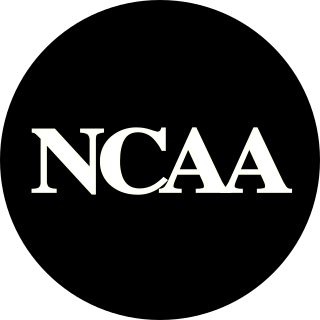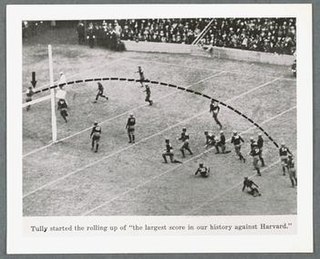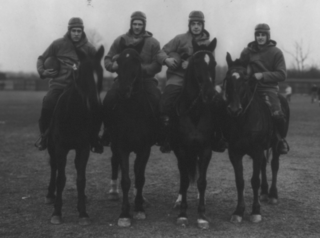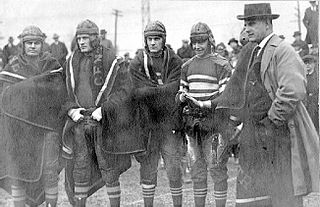
The Cotton Bowl Classic is an American college football bowl game played annually in the Dallas–Fort Worth metroplex since January 1, 1937.
The NCAA was without a playoff for the major college football teams in the University Division, later known as Division I-A, during the 20th century. The NCAA recognizes Division I-A national champions based on the final results of polls including the "wire service", FWAA and NFF. The 1964 AP poll continued to rank only ten teams, compiling the votes of 55 sportswriters, each of whom would give their opinion of the ten best. Under a point system of 10 points for first place, 9 for second, etc., the "overall" ranking was determined.

The 1980 NCAA Division I-A football season saw a university from the state of Georgia take its first national title since 1942.

Jimmy Leech was an American college football player. He was elected to the College Football Hall of Fame in 1956. Leech starred on the undefeated 1920 VMI Keydets football team, leading the nation in scoring. He is considered one of the greatest to ever play for the school.
The 1969 NCAA University Division football season was celebrated as the centennial of college football.
The 1957 college football season was the 89th season of intercollegiate football in the United States. It concluded with two teams having claim to the major college national championship:

The 1977 NCAA Division I football season was one in which the top five teams finished with 11–1 records. Notre Dame, which beat top-ranked and undefeated Texas in the Cotton Bowl, became the national champion.

The 1928 football season had both the USC Trojans and the Georgia Tech Golden Tornado claim national championships. USC was recognized as champions under the Dickinson System, but the Rose Bowl was contested between the No. 2 and No. 3 Dickinson-rated teams, California and Georgia Tech. The game was decided by a safety scored after Roy "Wrong Way" Riegels ran 65 yards in the wrong direction. Vance Maree blocked the ensuing punt which gave Georgia Tech a safety deciding the 8–7 win.

The 1925 college football season ended with no clear national champion. At the close of the season, noted sports writer Billy Evans described the championship contest as "a dead heat" among Dartmouth, Tulane, Michigan, Washington, and Alabama.

The 1924 college football season was the year of the Four Horsemen as the Notre Dame team, coached by Knute Rockne, won all of its games, including the Rose Bowl, to be acclaimed as the best team in the nation. Notre Dame and Stanford were both unbeaten at season's end, with the Fighting Irish winning the Rose Bowl contest 27–10. The Penn Quakers were retroactively awarded a national championship by Parke H. Davis.
The 1954 college football season was the 86th season of intercollegiate football in the United States. It saw three major college teams finish unbeaten and untied:
The 1953 college football season was marked by the NCAA Rules Committee's revocation of the two-platoon system and unlimited substitution rules in favor of the historic one-platoon system with its highly restrictive substitution rules. This radical rules shift made the 1953 season "The Year of the Great Adjustment," in the words of sportswriter Tommy Devine of the Detroit Free Press, in which teams scrambled to tighten their rosters and alter their strategies in accord with the more traditional "iron man" game.
The 1952 college football season was the 84th season of intercollegiate football in the United States. It ended with Oklahoma halfback Billy Vessels winning the Heisman Trophy and Notre Dame halfback Johnny Lattner winning the Maxwell Award. Two teams claim the 1952 national championship:
The 1951 college football season was the 83rd season of intercollegiate football in the United States. It finished with Princeton halfback Dick Kazmaier winning the Heisman Trophy and the Maxwell Award. Five teams have laid claim to the 1951 national championship:
The 1950 college football season was the 82nd season of intercollegiate football in the United States. It concluded with four teams having a claim to the national championship:
The 1949 college football season was the 81st season of intercollegiate football in the United States. It concluded with the top four teams undefeated and untied at the end of the regular season:

The 1919 college football season had no clear-cut champion, with the Official NCAA Division I Football Records Book listing Centre, Harvard, Illinois, Notre Dame, and Texas A&M as having been deemed national champions by major selectors Only Harvard, Illinois, and Texas A&M claim national championships for the 1919 season. Texas A&M began claiming the 1919 national championship in 2012.

The 1917 college football season ended with six undefeated teams in Georgia Tech, Pittsburgh, Ohio State, Texas A&M, Williams, and Washington State.

The 1928 Georgia Tech Golden Tornado football team represented the Georgia Institute of Technology during the 1928 Southern Conference football season. The team, which was a member of the Southern Conference (SoCon), was coached by William Alexander in his ninth year as head coach. Alexander compiled a record of 10–0 and outscored his opponents 213 to 40. Georgia Tech played its home games at Grant Field.
The Texas Longhorns football team represents the University of Texas at Austin in college football.










